DeFi is undergoing a transformation similar to the European Renaissance, with the market recovery, technological advancements, and changes in interest rates expected to become a core force for financial innovation in the future.
Author: @Arthur_0x
Translation: Blockchain in Plain Language
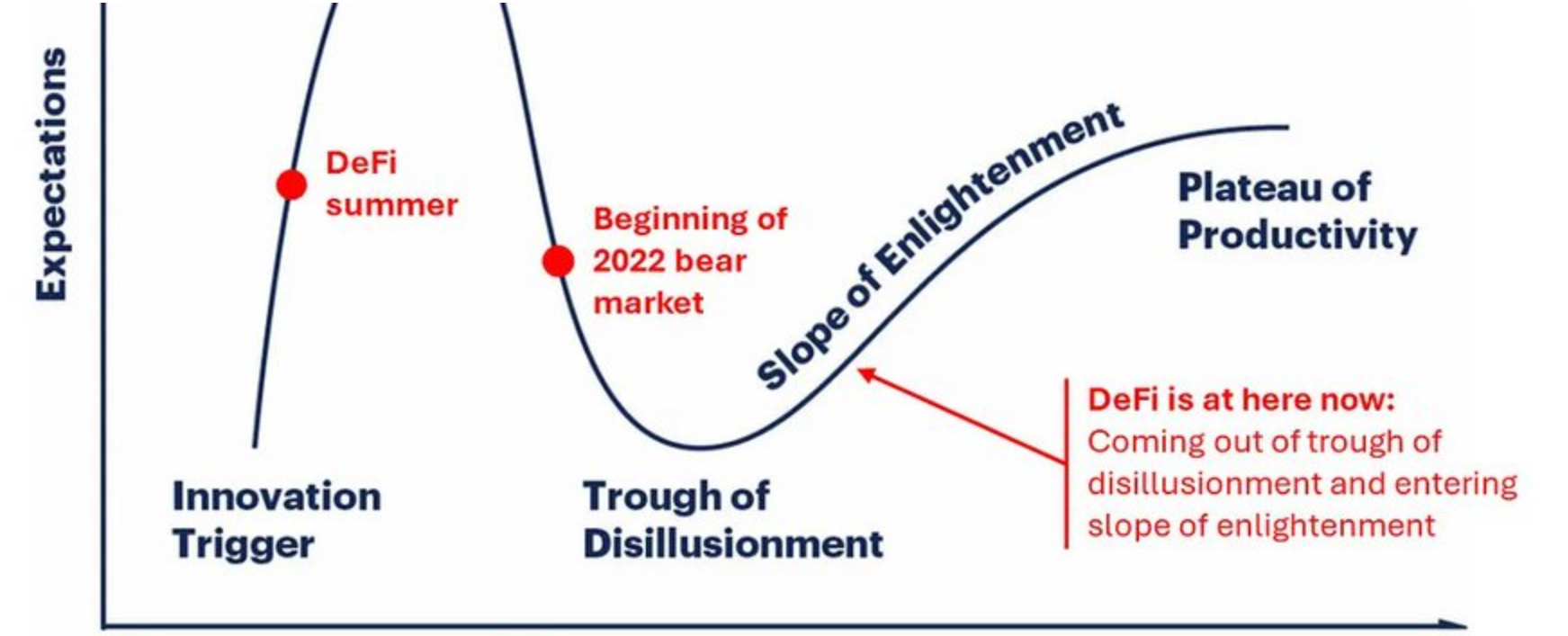
The European Renaissance began in the 14th century, igniting a revival of art, culture, and thought that fundamentally changed modern civilization.
Today, we are witnessing a similar awakening in the crypto space—the decentralized finance (DeFi) Renaissance. Like the historical Renaissance, this movement breaks down barriers and alters our perceptions of money and finance. Through blockchain and smart contracts, DeFi democratizes financial services, enabling people worldwide to access a trustless economy without traditional financial intermediaries. This has the potential to radically change the landscape of finance.
Just as the European Renaissance benefited from technological advancements and social changes, the DeFi Renaissance is also driven by key factors that have allowed it to overcome early challenges and enter a new era of growth and innovation.
1. DeFi is Emerging from the Valley of Disillusionment
DeFi experienced rapid growth in 2020 and 2021, with many holding high expectations that it would revolutionize traditional finance (TradFi). However, like most new technologies, the early hype led to disappointment as its infrastructure proved insufficiently mature, resulting in a decline in 2022.
Yet, as with any revolutionary movement, DeFi has become more resilient after experiencing the "valley of disillusionment" and is beginning to ascend the "slope of enlightenment." The Gartner Hype Cycle is an effective framework to illustrate this journey, and currently, DeFi is showing signs of recovery.
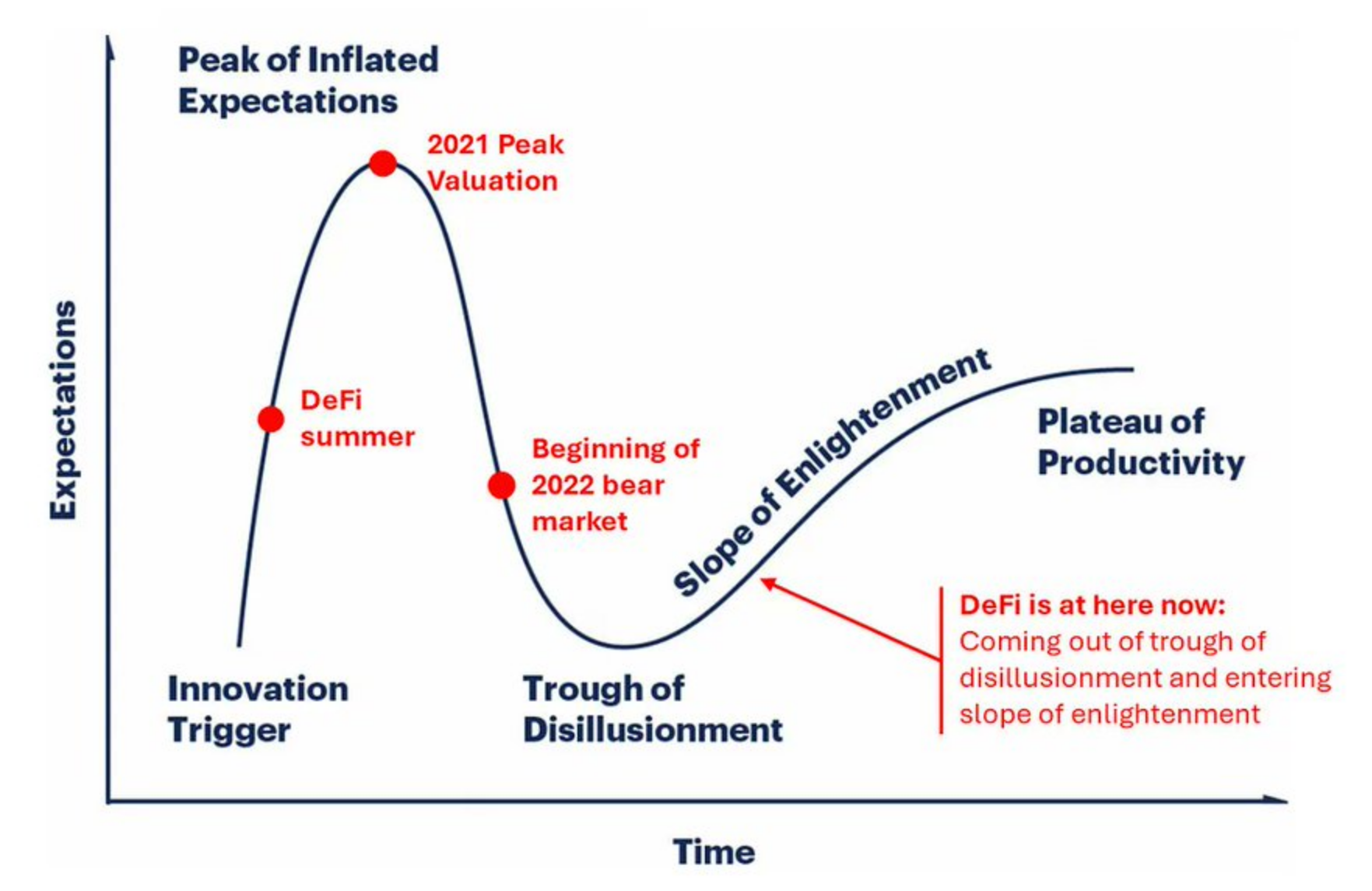
After two years of adjustment, key metrics like Total Value Locked (TVL) are rebounding, as clearly shown in the chart below. While some improvements in metrics are due to rising crypto asset prices, the trading volume on DeFi platforms has also significantly increased, nearly returning to 2022 levels, proving that a recovery is indeed underway.
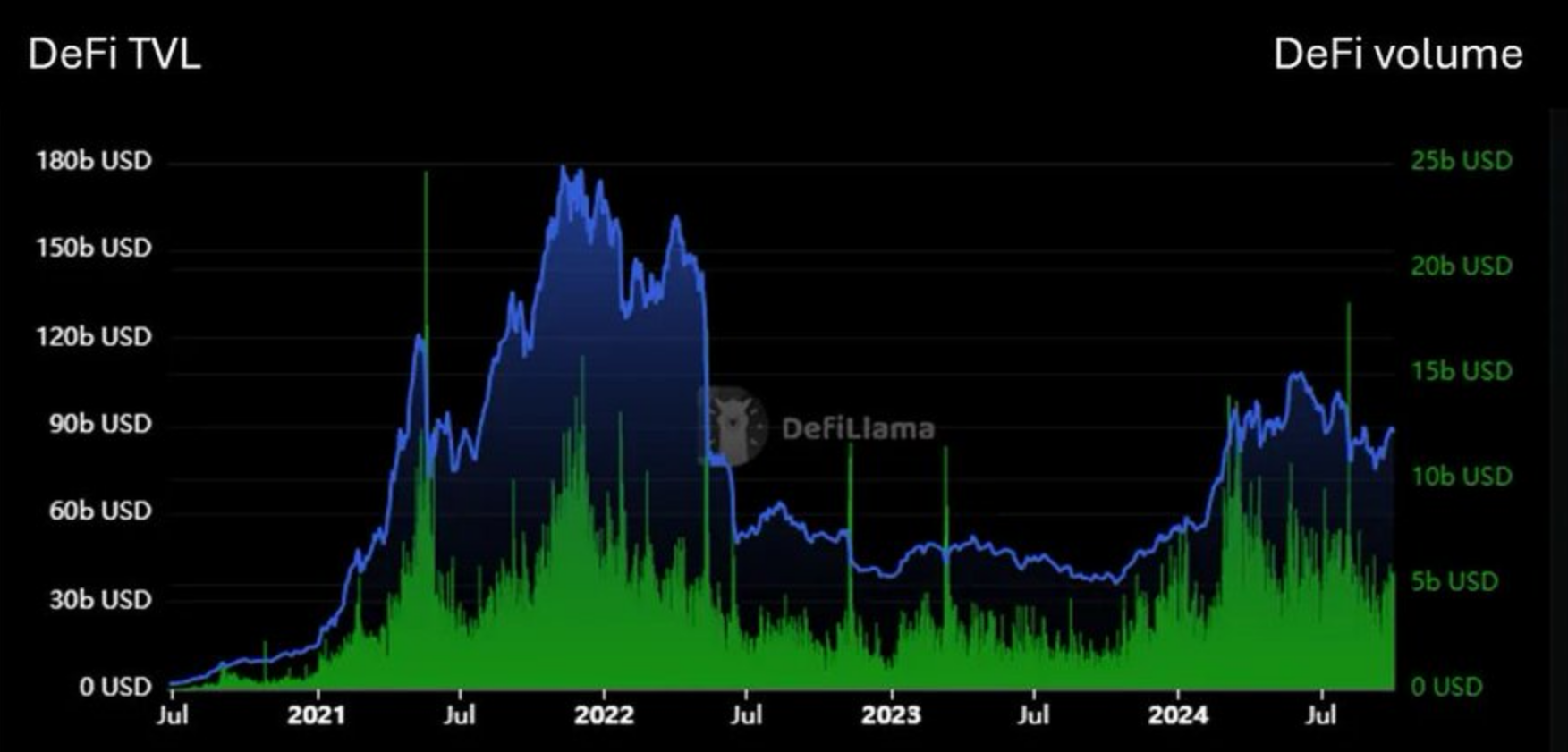
In fact, some foundational DeFi projects, such as Aave, have even surpassed their 2022 peaks on multiple metrics. For example, Aave's quarterly revenue has exceeded the levels of Q4 2021, which was considered the peak of the last bull market.
This marks that DeFi is maturing and entering a new phase of productivity, preparing for long-term scalability.
2. The New Interest Rate Cycle Will Make DeFi Returns More Attractive
The recovery of DeFi is driven not only by internal factors but also by external economic changes. As global interest rates fluctuate, risk assets like cryptocurrencies and DeFi become more attractive to investors seeking higher returns.
With the Federal Reserve implementing a 50 basis point rate cut in September, we may be entering a low-interest-rate period, similar to the environment that drove the crypto bull markets of 2017 and 2020, as shown in the chart below. Bitcoin (and cryptocurrencies) bull markets are marked in green, historically occurring in low-interest-rate environments, while bear markets are marked in red, typically appearing during periods of rising rates.
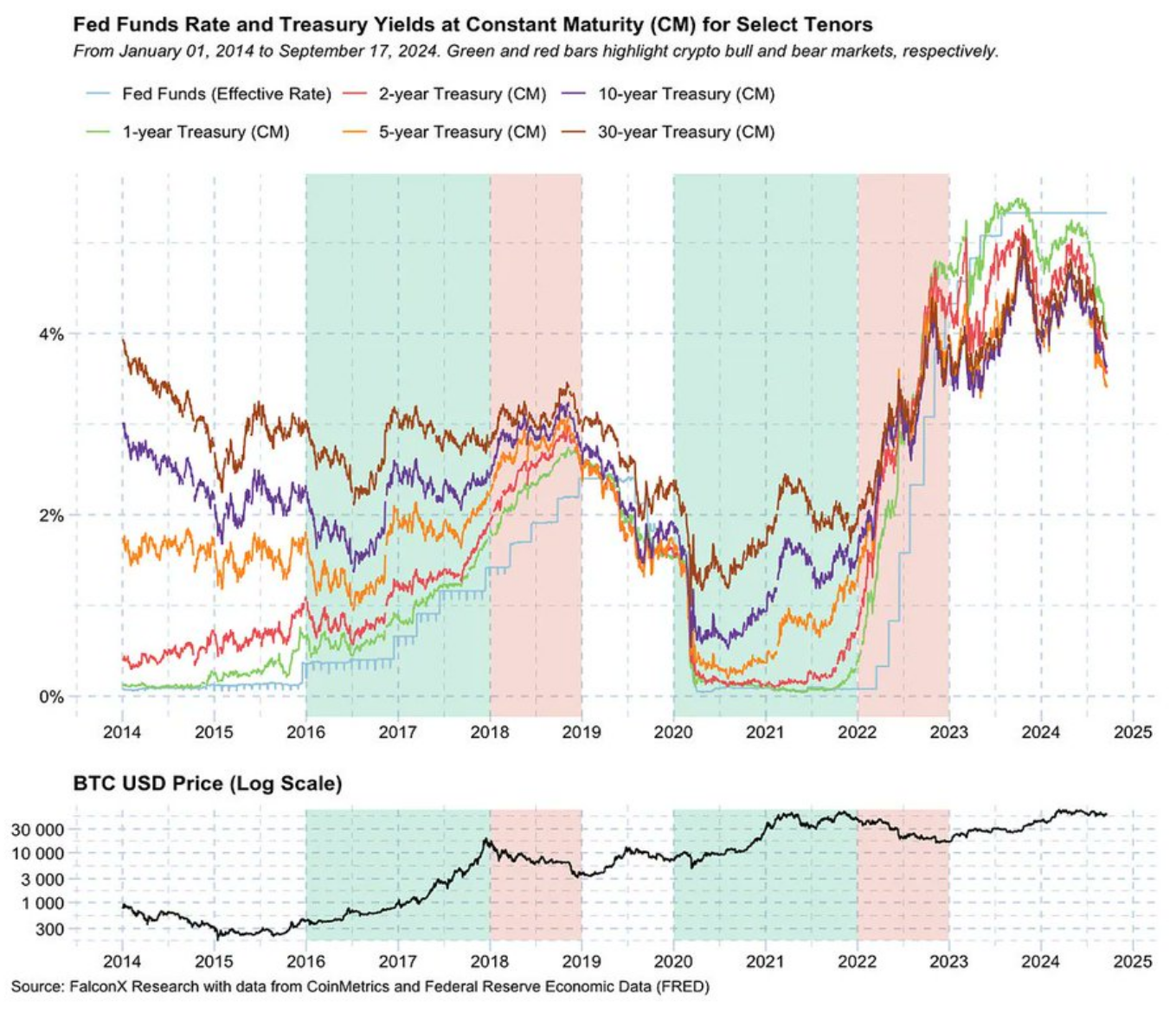
DeFi benefits in a low-interest-rate environment in two key ways:
1) Lower Opportunity Cost of Capital—As interest rates decline, the returns on government bonds and traditional savings accounts decrease, prompting investors to turn to DeFi protocols that offer higher yields, such as yield farming, staking, and liquidity provision.
2) Lower Borrowing Costs—Reduced financing costs encourage DeFi users to borrow and use funds for productive purposes, thereby driving activity across the entire ecosystem.
While interest rates may not drop to near-zero levels seen in past cycles, the opportunity cost of participating in DeFi will significantly decrease. Even a moderate decline in rates can have a substantial impact, as the difference between rates and yields is magnified under leverage.
Additionally, we expect the new interest rate cycle to be a significant driver of stablecoin growth, as it significantly lowers the capital costs for traditional financial funds seeking yield to shift to DeFi.
In the previous cycle, there was an inverse relationship between the federal funds rate (FFR) and the growth of stablecoin supply, as shown below. As rates decline again, stablecoin supply is expected to grow, providing more funding support for the acceleration of DeFi.

3. Finance: (Still) the Largest Product Market for Cryptocurrencies
The crypto space has attempted various use cases, such as NFTs, the metaverse, gaming, and social applications. However, from most objective indicators, these use cases have not truly found product-market fit (PMF).
Consider the following case: even after a brief revival of Bitcoin Ordinals in 2024, the daily trading volume of NFTs continues to decline.
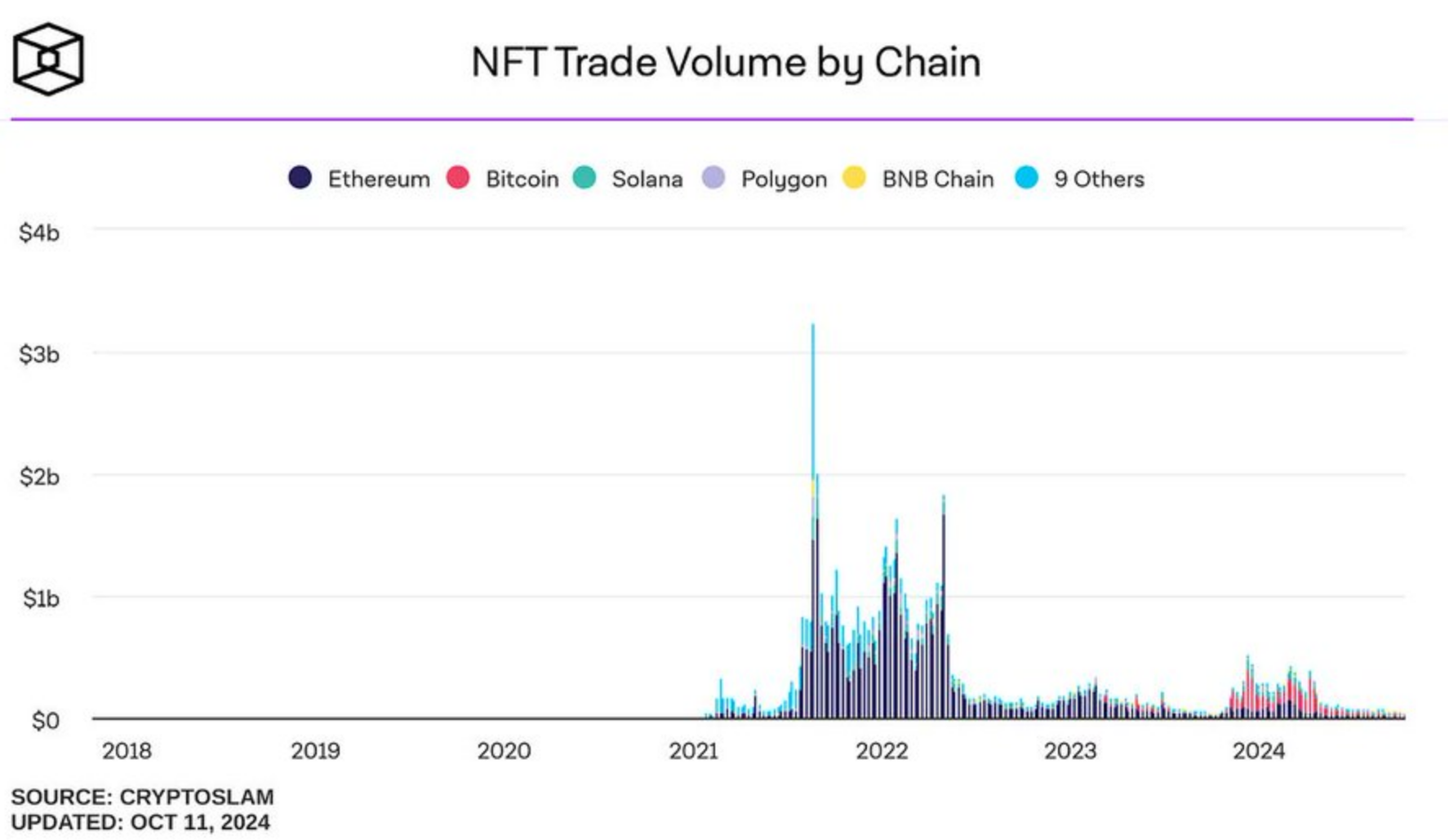
As for the metaverse and gaming, there are currently no breakthrough Web3 games that have gained widespread popularity globally. The two established Web3 metaverses, Decentraland and Sandbox, struggle to maintain even a few thousand daily active users, while Roblox boasts 80 million daily active users. Although the daily active users of TON games are quite substantial, it remains uncertain how many will continue to play on TON without financial incentives.
On the other hand, DeFi has proven its product-market fit. The growth of core DeFi categories such as liquid staking and borrowing has exceeded 100%, which is a strong testament to its popularity. Meanwhile, some new billion-dollar categories, such as restaking (Eigenlayer) and basis trading (Ethena), had no Total Value Locked (TVL) a year ago and are now gradually emerging. This explosive growth showcases the composability and permissionless nature of DeFi, where new financial "Legos" stack on top of each other, opening up new application scenarios.
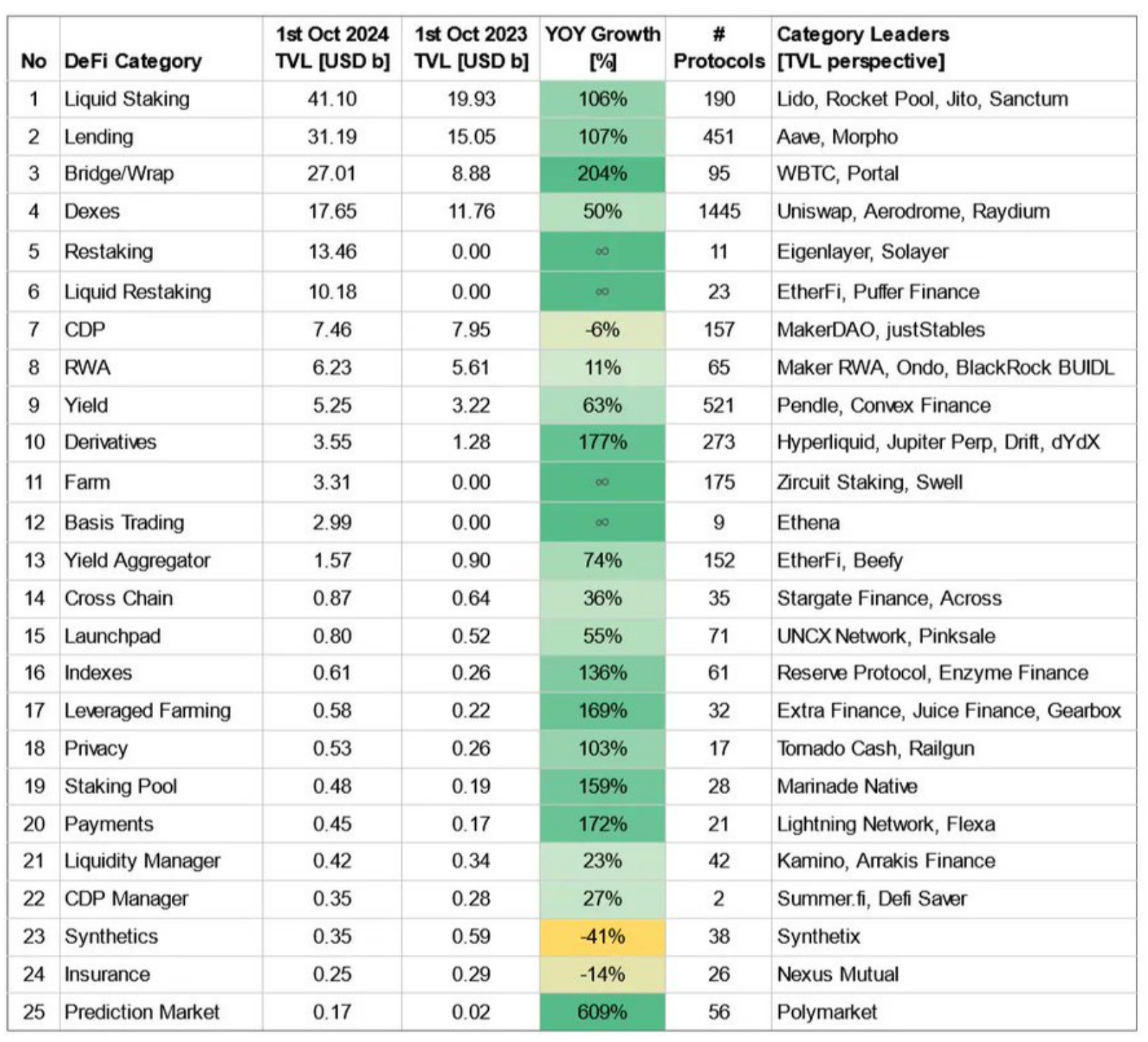
Regulatory barriers have long limited the potential of DeFi to disrupt traditional finance (TradFi), but the inherent advantages of DeFi are very clear. For example:
Cross-border transaction and remittance fees average 6%, and transfers take 3 to 5 business days.
The backend systems of stock trading platforms are complex and have limited operating hours, leading to inefficiencies.
Real-world assets, such as real estate, can release liquidity through tokenization and achieve composability in DeFi, such as being used as collateral.
DeFi operates around the clock, with low costs, high liquidity, and no intermediaries, making it a more efficient choice. The technology has matured, and the challenge lies in whether regulators will allow DeFi to disrupt the $100 trillion global financial markets that rely on inefficient operations.
**To illustrate the efficiency advantages of **DeFi, we can compare the service costs of these two systems. According to research by the International Monetary Fund (IMF), the specifics are as follows:
Labor Costs: DeFi has almost no labor costs, while TradFi's labor costs range from 2% to 3%. For example, DeFi loans are processed automatically without human intervention, whereas TradFi requires manual reviews and cumbersome paperwork.
Operating Costs: DeFi's operating costs are only 0.1%, while TradFi's operating costs range from 2% to 4%. DeFi does not require large offices or intermediaries, as smart contracts can handle transactions, and blockchain provides verification.
Overall, in developed economies, TradFi's marginal costs reach 6% to 8%, while in emerging markets, they range from 10% to 14%, and these costs are ultimately passed on to users.
DeFi eliminates these inefficiencies, which is its brilliance and simplicity.
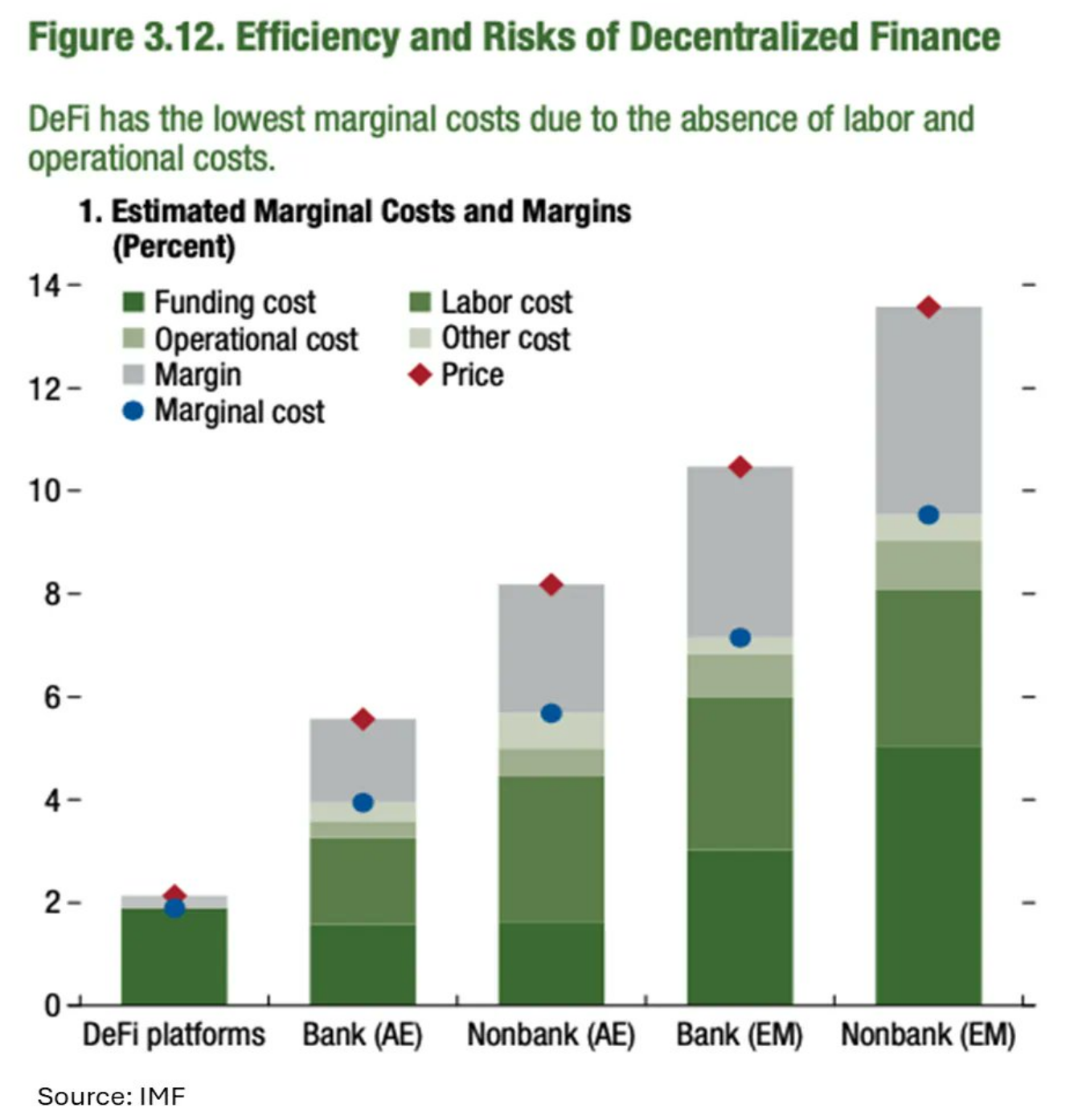
Moreover, the fintech sector has seen almost no innovation in the past 15 years, which aligns with research from Blockchain Capital. Despite significant advancements in areas like artificial intelligence and global internet access, fintech still relies on outdated systems, such as the SWIFT system that all banks have been using for 50 years, where transfers typically take 1 to 4 business days.
Most fintech advancements, such as digital payments, fractional shares, and APIs, have primarily focused on improving user experience rather than addressing the core inefficiencies of traditional finance (TradFi). For instance, Robinhood and Plaid provide convenient stock purchasing solutions for everyone, but they still depend on old financial infrastructure. The real issue is that fintech connects outdated systems to maximize their utilization efficiency rather than creating something entirely new. While these changes are beneficial, they do not address the deep-seated problems plaguing the traditional financial world.
DeFi, on the other hand, was built for digitization from the start. DeFi does not circumvent the old financial system; it directly embeds financial services into the internet. In DeFi, features like fractional shares, over-collateralized loans, and global payments are not innovations but rather basic characteristics. This marks a fundamental shift from minor improvements to a comprehensive reform of how financial operations are conducted.
**By adopting **DeFi, we can move beyond minor fixes and begin to unlock enormous new economic opportunities, enhance financial accessibility, and create wealth in areas often overlooked by traditional finance. This is about reconstructing the financial system to better fit the digital world.
Looking ahead, the 2024 U.S. elections may provide regulatory clarity. Trump's presidency could bring crypto-friendly regulations, while the Harris administration's recent warming towards the industry may maintain a positive stance. Regardless of the political outcome, the momentum behind DeFi is undeniable.
DeFi is just getting started, and the future of finance will be decentralized and on-chain.
4. Enhanced User Interface/User Experience, Infrastructure, and Security
The early stages of DeFi alienated users due to cumbersome interfaces and technical complexity. However, significant improvements in user experience, infrastructure, and security over the past few years have made DeFi more accessible to mainstream users.
One of the most notable advancements is the improvement in wallet infrastructure. Managing mnemonic phrases and private keys was a major barrier, but new smart wallets and embedded wallets have simplified and secured this process. Features like social recovery, biometric authentication, and passwordless login make it easier for users to manage their funds, freeing them from the complexities of traditional Web3 wallets.
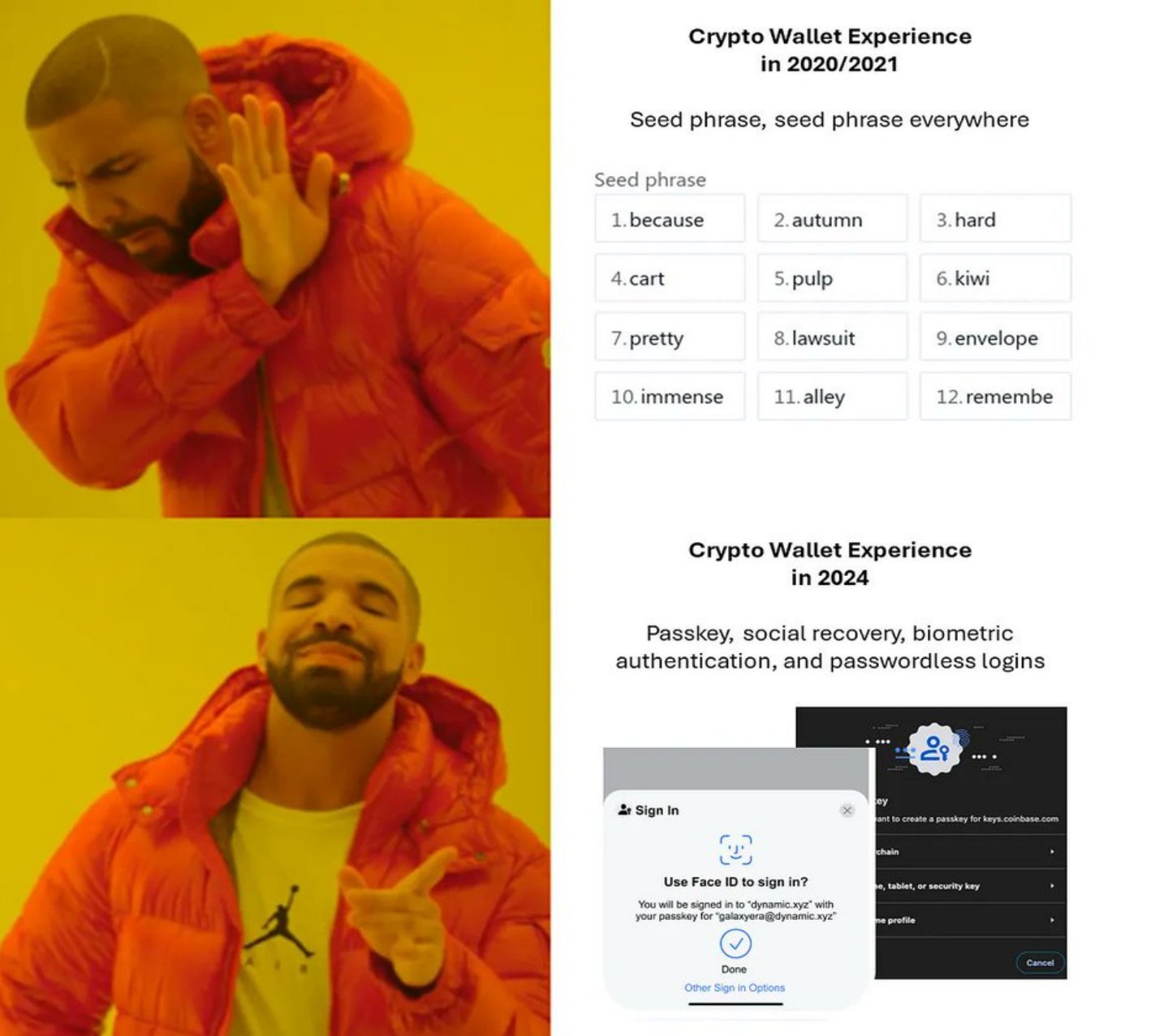
Security has also improved, with comprehensive audits of smart contracts before deployment becoming standard. Platforms like ImmuneFi encourage ethical hackers to find bugs and security issues through bounty programs, ensuring timely fixes before vulnerabilities are exploited. These developments in wallet infrastructure and security have made DeFi safer and more efficient for all users, as evidenced by the significant decrease in DeFi hacking incidents over the past year.
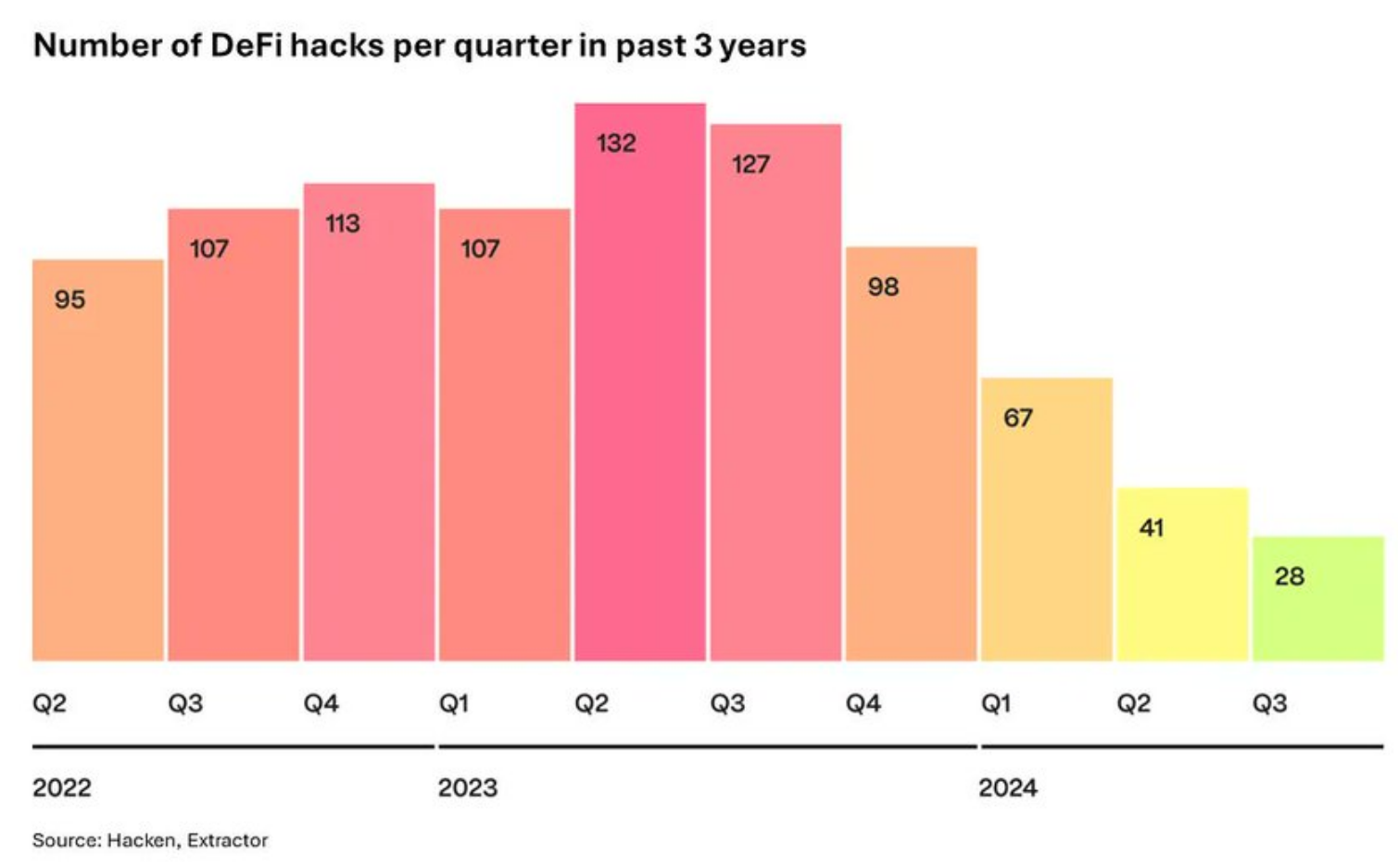
With these improvements, DeFi is becoming increasingly accepted by the mainstream market, including institutional adoption, driving its continued growth.
5. Making DeFi Great Again
**Just as the European Renaissance reshaped society, *DeFi* will fundamentally revolutionize finance.** The innovative potential within DeFi is immense, and we are only beginning to see its impact. As more users and investors embrace DeFi, the future of global finance will increasingly shift on-chain, making financial systems more efficient, open, and accessible to everyone.
DeFi has the power to eliminate inefficiencies, break down barriers, and create new opportunities for financial inclusion. This is not just a fleeting trend but a fundamental transformation in how the world interacts with money. From global payments to making financial services accessible to all, DeFi offers a future where anyone can participate in the financial system.
Currently, the total market capitalization of all DeFi protocols is approximately $33 billion, which accounts for about 1.4% of the total cryptocurrency market capitalization of $2.3 trillion.
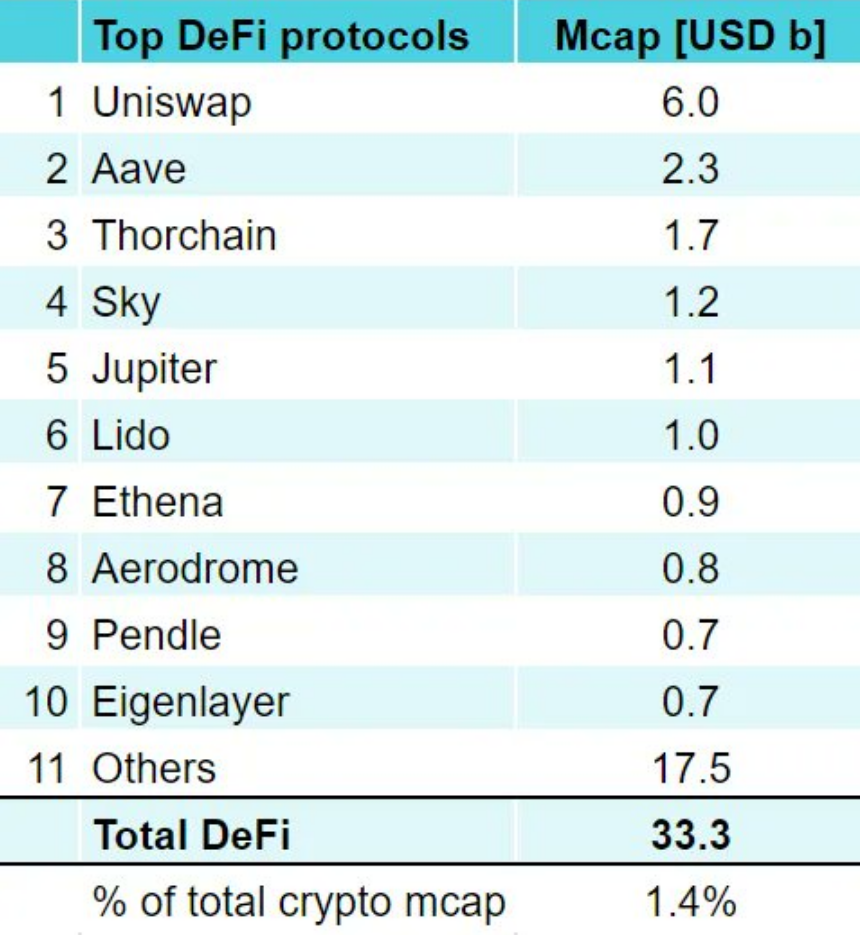
Data as of October 13, 2024
Given the challenging market conditions and industry environment, the growth and success of DeFi have recently been largely overlooked. However, as DeFi protocols continue to grow at an astonishing rate and return this increasing value to token holders, as seen with Aave in their recent tokenomics reform proposal, market participants will further recognize the fundamentals and potential of DeFi and reallocate their capital accordingly.
We expect that as DeFi continues to grow and the market awakens to its latest traction and new potential, the share of these DeFi assets in the total cryptocurrency market capitalization will grow from 1.4% to 10% within the next two years.
Make DeFi great again.
Note: This document is for informational purposes only. The views expressed in this document are not, and should not be construed as, investment advice or recommendations.
Article link: https://www.hellobtc.com/kp/du/10/5475.html
Source: https://x.com/Arthur_0x/status/1845844922085335457
免责声明:本文章仅代表作者个人观点,不代表本平台的立场和观点。本文章仅供信息分享,不构成对任何人的任何投资建议。用户与作者之间的任何争议,与本平台无关。如网页中刊载的文章或图片涉及侵权,请提供相关的权利证明和身份证明发送邮件到support@aicoin.com,本平台相关工作人员将会进行核查。




